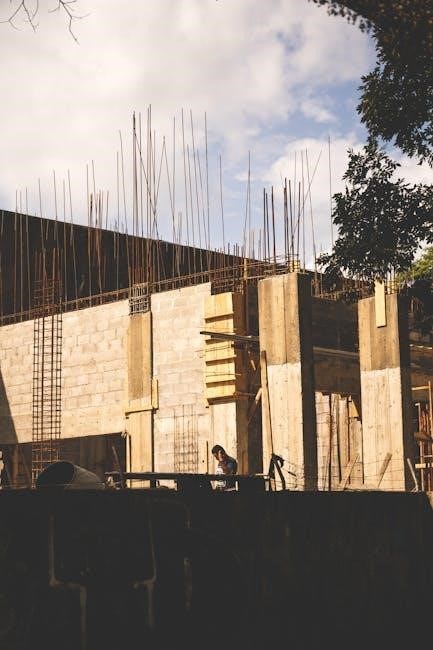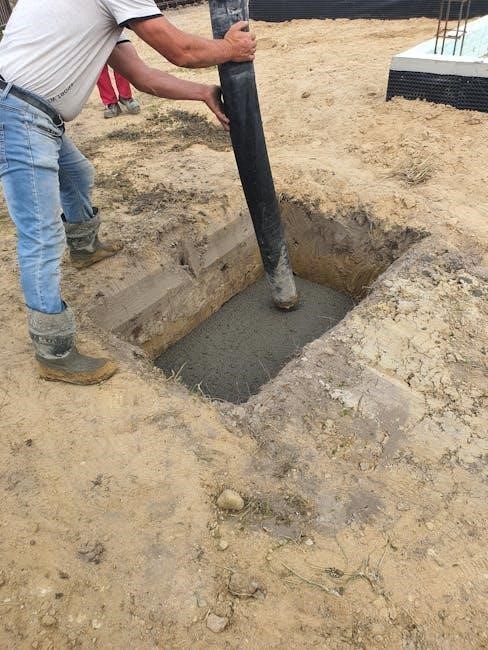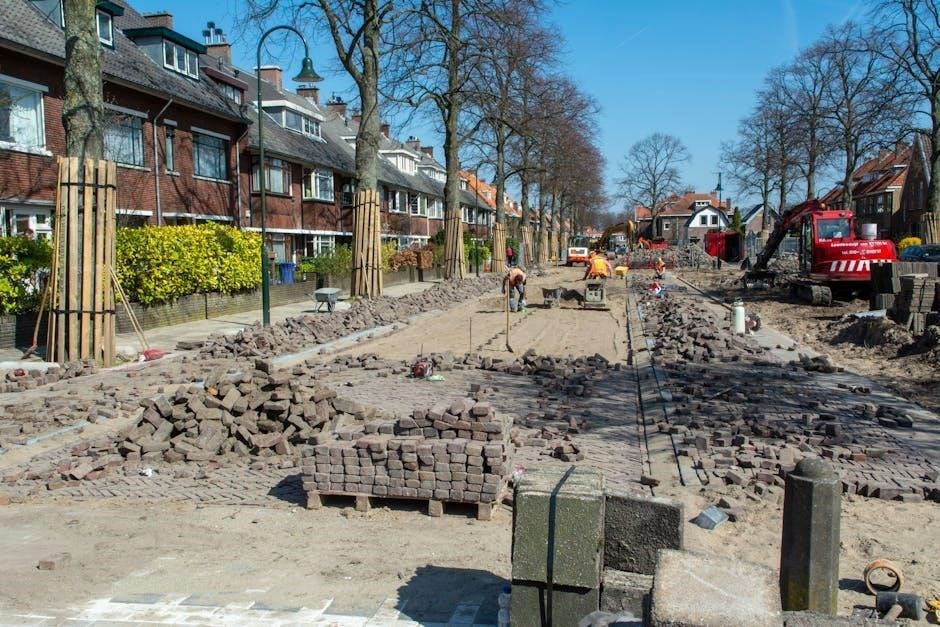The Canadian Foundation Engineering Manual is a comprehensive resource for geotechnical engineering in Canada‚ published by the Canadian Geotechnical Society. The 5th edition‚ released in 2023‚ provides updated guidance on foundation design‚ permafrost engineering‚ and ground vibrations‚ addressing modern challenges in Canadian construction and climate conditions.
Significance of the Manual in Canadian Engineering
The Canadian Foundation Engineering Manual is a cornerstone for geotechnical engineering practices in Canada. It provides standardized guidelines‚ best practices‚ and cutting-edge research to ensure safe and efficient foundation design and construction. The manual addresses unique Canadian challenges‚ such as permafrost conditions and climate change impacts‚ making it indispensable for engineers nationwide. Its comprehensive approach supports professional development and contributes to the advancement of infrastructure projects across Canada‚ fostering innovation and reliability in the field.
Historical Background and Development
The Canadian Foundation Engineering Manual has a rich history‚ with its first edition published in 1978 after revising a 1975 draft. Developed by the Canadian Geotechnical Society‚ it aimed to standardize geotechnical practices nationwide. Over the years‚ the manual evolved to address emerging challenges‚ culminating in the 5th edition in 2023. This edition incorporates advancements in permafrost engineering‚ climate change impacts‚ and ground vibrations‚ reflecting Canada’s unique environmental conditions and the expertise of its engineering community.

Overview of the 5th Edition
The 5th Edition of the Canadian Foundation Engineering Manual‚ released in October 2023‚ is a major update addressing permafrost‚ climate change‚ and ground vibrations‚ essential for Canadian engineering.
New Chapters and Updates in the 5th Edition
The 5th Edition introduces five new chapters focusing on Geology‚ Permafrost‚ Physiography‚ and Climate Change in Canada‚ as well as Ground Vibrations and Foundations in Permafrost. These updates reflect the evolving challenges in Canadian engineering‚ particularly in regions affected by thawing permafrost due to climate change. Additionally‚ the manual incorporates the latest research and practices in foundation design‚ ensuring engineers have access to cutting-edge methodologies. These enhancements make the 5th Edition indispensable for professionals addressing modern geotechnical demands across Canada.

Key Features of the 2023 Release
The 5th Edition of the Canadian Foundation Engineering Manual‚ released in October 2023‚ offers enhanced content tailored to modern engineering challenges. It is available exclusively in electronic format‚ ensuring easy access and portability. The manual includes watermarked PDFs to prevent unauthorized distribution. Key updates focus on addressing climate change impacts‚ particularly in permafrost regions‚ and provide advanced guidance on ground vibrations and specialized foundations. These features make the 2023 release a vital tool for engineers working in Canada’s diverse and evolving geotechnical landscape.

Publishing and Availability
The Canadian Foundation Engineering Manual is published by the Canadian Geotechnical Society. The 5th Edition was released in October 2023 and is available electronically. It can be purchased online and downloaded as a watermarked PDF‚ ensuring authorized use and distribution.
Role of the Canadian Geotechnical Society
The Canadian Geotechnical Society (CGS) plays a pivotal role in the development and publication of the Canadian Foundation Engineering Manual. As the publisher‚ CGS ensures the manual adheres to the highest standards of geotechnical engineering practice in Canada. The society collaborates with industry experts and researchers to compile and update the content‚ reflecting the latest advancements in foundation engineering. CGS also facilitates the manual’s distribution‚ making it accessible to professionals nationwide. Its commitment to excellence has established the manual as a cornerstone of Canadian engineering resources.
Accessing the Manual in Electronic Format
The Canadian Foundation Engineering Manual 5th Edition is available in electronic format‚ providing convenient access for professionals. After purchasing‚ users can download the PDF‚ which is watermarked with their name for copyright protection. The electronic version ensures portability and easy reference‚ making it a practical choice for engineers and researchers. This format aligns with modern workflows‚ enhancing accessibility and usability while maintaining the manual’s authoritative content.

Structure and Content
The 5th Edition of the Canadian Foundation Engineering Manual includes detailed chapters on geology‚ permafrost‚ and ground vibrations‚ providing comprehensive guidance for modern engineering practices in Canada.
Detailed Chapters on Geology and Permafrost
The 5th Edition includes in-depth chapters on Canadian geology and permafrost conditions‚ offering insights into regional soil types‚ thawing impacts‚ and foundation design in cold climates. These chapters address climate change effects‚ providing engineers with critical data to ensure stable and sustainable constructions in permafrost regions. Updated content reflects recent research and practical applications‚ making it a vital resource for engineers tackling northern and permafrost-related projects across Canada.
Ground Vibrations and Specialized Foundations
The 5th Edition introduces new chapters on ground vibrations and specialized foundations‚ addressing dynamic soil behavior and advanced foundation designs. These sections provide detailed analyses of vibration sources‚ transmission‚ and mitigation techniques‚ crucial for structures in seismically active or industrially vibrant areas. Specialized foundations‚ such as piles and caissons‚ are explored in depth‚ offering innovative solutions for challenging ground conditions. This content equips engineers with tools to design safer‚ more resilient structures‚ reflecting current research and expert practices in geotechnical engineering.

Downloading and Usage
The 5th Edition is available in electronic format. After purchase‚ users can download the PDF‚ which is watermarked for security. Usage guidelines ensure proper distribution and access.

Steps to Purchase and Download the PDF
To obtain the 5th Edition‚ visit the Canadian Geotechnical Society’s website. Follow these steps: select the manual‚ add to cart‚ and proceed to checkout. Enter payment details securely. Upon completion‚ click the “Get Access” button to download the PDF. The document will be watermarked with your name to ensure authorized use. Ensure your device meets system requirements for smooth access. This process guarantees legal and secure acquisition of the updated manual.
Watermarking and Usage Guidelines
Each purchased PDF of the 5th Edition is watermarked with the buyer’s name to ensure authorized use. The manual is for individual use only and may not be shared‚ copied‚ or redistributed. Users are prohibited from downloading or retaining substantial portions of the content. Adherence to these guidelines is mandatory to comply with the licensing terms set by the Canadian Geotechnical Society‚ ensuring the protection of intellectual property and maintaining the integrity of the publication.

Applications in Canadian Engineering
The Canadian Foundation Engineering Manual is essential for designing foundations in Canada’s diverse geological conditions‚ addressing permafrost‚ ground vibrations‚ and climate change impacts on infrastructure.
Practical Uses in Foundation Design and Construction
The Canadian Foundation Engineering Manual provides critical guidance for engineers designing foundations in Canada’s challenging geological environments. It offers detailed methodologies for constructing shallow and deep foundations‚ considering permafrost conditions and ground vibrations. The manual includes updated design approaches to address climate change impacts on soil stability. Engineers rely on its practical insights for ensuring structural integrity and safety in diverse projects‚ from urban buildings to remote infrastructure. Its comprehensive coverage makes it indispensable for meeting Canada’s unique engineering challenges effectively.
Relevance to Climate Change and Permafrost Conditions
The 5th Edition emphasizes the impact of climate change on geotechnical engineering in Canada‚ particularly in permafrost regions. Rising temperatures alter soil stability‚ affecting foundation designs. The manual includes new chapters addressing these challenges‚ providing updated methods for constructing foundations in thawing permafrost. It also covers ground vibrations and their implications for structures in sensitive environments. These updates ensure engineers are equipped to design resilient infrastructure amid changing climatic conditions‚ safeguarding projects across Canada’s diverse and evolving landscapes.

Impact and Industry Reception
The 5th Edition has been well-received by professionals‚ offering significant updates and expert contributions‚ solidifying its role as a trusted resource in Canadian geotechnical engineering.
Contributions from Leading Experts and Organizations
The 5th Edition of the Canadian Foundation Engineering Manual reflects collaborative efforts from leading experts and organizations across Canada. The Canadian Geotechnical Society‚ alongside prominent engineering firms and academic institutions‚ contributed significantly to its development. Notably‚ professionals from WSP in Canada played a key role in shaping the manual’s updated content. Their expertise ensured the inclusion of cutting-edge research and practical insights‚ particularly in areas like permafrost engineering and ground vibrations. This collective effort underscores the manual’s authority as a trusted resource for geotechnical engineering in Canada.
Feedback from Professionals in the Field
Professionals in geotechnical engineering have praised the 5th Edition of the Canadian Foundation Engineering Manual for its comprehensive updates and practical relevance. Engineers and academics have highlighted its improved clarity and the inclusion of cutting-edge research‚ particularly in areas like permafrost and ground vibrations. Many have commended the manual’s ability to address contemporary challenges‚ such as climate change impacts on infrastructure. The contributions from leading experts‚ including those from WSP Canada‚ have been recognized for enhancing the manual’s authority and usability in the field.
The Canadian Foundation Engineering Manual‚ now in its 5th edition‚ remains a cornerstone for advancing geotechnical engineering in Canada‚ offering updated‚ authoritative guidance for professionals nationwide.
The Future of Foundation Engineering in Canada
The 5th edition of the Canadian Foundation Engineering Manual underscores the evolving landscape of geotechnical engineering in Canada‚ emphasizing climate change‚ permafrost‚ and advanced construction techniques. With new chapters on ground vibrations and specialized foundations‚ the manual aligns with emerging challenges‚ ensuring engineers are equipped to address complex projects. The integration of cutting-edge research and practical insights highlights the manual’s role in shaping the future of foundation engineering‚ fostering innovation and sustainability in Canada’s infrastructure development.
Importance of Staying Updated with the Manual
Staying updated with the Canadian Foundation Engineering Manual is crucial for engineers to adapt to evolving geotechnical challenges‚ particularly in permafrost regions and climate change scenarios. The 5th edition includes new chapters on ground vibrations‚ permafrost engineering‚ and climate change mitigation‚ ensuring engineers are equipped with the latest knowledge. Regular updates reflect advancements in research and practice‚ enabling professionals to design safe‚ efficient‚ and sustainable foundations. Adhering to the manual’s guidelines ensures compliance with current standards and best practices‚ critical for addressing Canada’s unique geotechnical conditions effectively.
